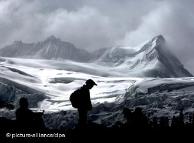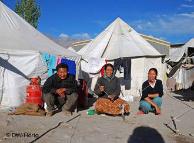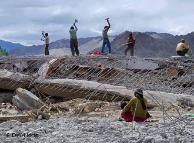Climate | 01.12.2010
Melting Himalayan glaciers herald floods and droughts for region
During the night of August 6 last year, the small town of Leh, the capital of India's northernmost province Ladakh, experienced freak weather conditions.
"In that night the weather was unusual. Lightning lit up the sky, thunder shook the mountains, and then it started to rain heavily. It wasn't raining long, but it was the heaviest rainfall I have ever experienced," Karma Jamyang a farmer in Leh described the events.
"Suddenly the front door burst open, water and mud poured in. We panicked. We wanted to get away, but where? Right and left, raging water, mud and stones."
He and his family escaped by the skin of their teeth, climbing to the roof of their home. They lost most of their worldly possessions within a few hours, buried under meters of mud.
Others were still less fortunate. The storm claimed almost 200 lives in Leh and the surrounding area.
Karma Jamyang and his family were lucky to survive the flood
Climate Change to blame
The Ladakh region is a high-desert, situated 3500 meters above sea level in the rain shadow of the Himalayas.
It is about as dry here as in the Sahara Desert. The heavy rains last August were a freak weather event, which Indian meteorologists have linked to global climate change.
According to the International Research Institute for the Himalayan Hindukhush region in Kathmandu, Nepal's climate in the mountain region is warming more than the global average.
Last year the French Development Agency GERES published a major study on climate change in the Indian Himalayas. GERES evaluated the past 35 years of data from the only weather station in Ladakh and interviewed hundreds of villagers.
"The minimum temperature in winter months in Leh has increased by nearly one degree Celsius. The maximum temperature in Leh has increased by nearly 0.5 degrees Celsius for summer months over the past 35 years," Samten Choephel, who works for GERES, said.
He added that the vast majority of the villagers confirmed these trends. The survey also indicated that less snow has been falling in winter amid warmer conditions.
Many farmers observed that their fruit trees were flowering earlier, that migratory birds were staying longer, and that wheat could be harvested at elevations previously only suitable for barley.
In the desert climate of Ladakh agriculture is entirely dependent on irrigation. If, however, less snow falls and at the same time the temperatures rise, the glaciers get less snow supply and begin to melt.
The people of Ladakh are already feeling the consequences.
"Most of the villagers, I would say about 80 percent, depend on the melt water from glaciers for drinking and cooking, and also to irrigate the fields," said Samten Choephel. "The rapid melting of glaciers has caused water shortages, and that means many farmers have lower yields."
Farmers clear up in the aftermath of the storm in Leh.
The glaciers are melting, but how fast?
Yet the study and observation of the Himalaya's glaciers is still in its infancy, not least because of the region's inaccessibility.
The Indian government only set up a glacier research center last year in the Himalayan town of Dehra Dun.
There Dwarijka Dhobal is kept busy observing climate change in motion.
"The mouths of the glaciers through which the melt water flows out are receding by five to twenty meters every year. The volume is also reducing, the ice gets on average 30 cm thinner each year."
Earlier this year, the Himalaya's glaciers became the focus of a controversy surrounding the UN's Intergovernmental Panel on Climate Change (IPCC). The panel's fourth assessment report, published in 2007, contained a paragraph with the false claim that the glaciers would melt by 2035.
Although it later emerged that the true figure should have read 2350, the fact that the glaciers on the highest mountains in the world are melting is not contested, according to Dwarijka Dhobal.
"Many millions of people depend on the melt water from the Himalayan glaciers to survive," Dhobal added.
"Outside of the rainy season, especially, in the hot, dry summer months, the area gets up to 35% of its water from melt water. Therefore, it's predicted that large parts of South Asia will suffer water shortages."
Author: Rainer Hoerig, Natalia Dannenberg
Editor: Nathan Witkop



